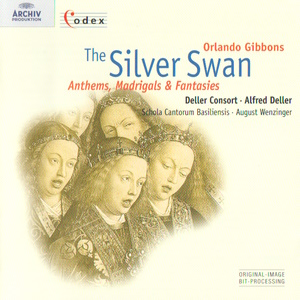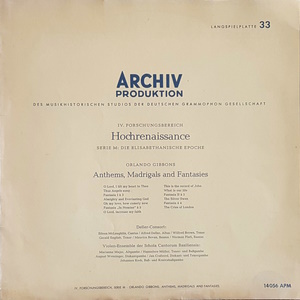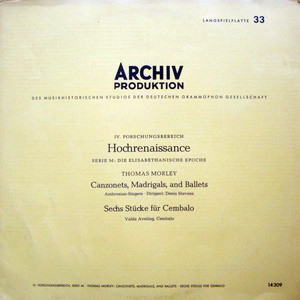 |
|
1 CD -
453 166-2 - (p) 1996
|
|
| 50
Jahre (1947-1997) - Codex I Serie - 5/10 |
|
|
|
|
|
|
|
| THE SILVER SWAN -
Anthems, Madrigals & Fantasies |
|
|
|
|
|
|
|
| Orlando
GIBBONS (1583-1625) |
|
|
|
|
| O Lord, I lift my
heart to Thee - Anthem a 5
(ATTBB) |
Edition: Tudor
Church Music, iv (1925) [TCM], p.
259
|
|
1' 54" |
1
|
Thus Angels sung
- Hymn a 4 (ATTB)
|
Source: G. Wither, The
Hymnes and Songs of the Church
(London, 1623); ed. in TCM
|
|
1' 15" |
2 |
Fantasia I a
3 - Descant viol, tenor viol, bass
viol
|
Source: Fantasias
a 3 (London, c. 1620); ed. F.
J. Giesbert (Hannover)
|
|
2' 35" |
3 |
Almighty and
everlasting God - Anthem a 4
(SATB)
|
Edition: TCM, p. 126
|
|
2' 47" |
4 |
O my love, how
comely now - Hymn a 4 (ATTB)
|
Source: G. Wither, The
Hymnes and Songs of the Church
(London, 1623); ed. in TCM |
|
1' 15" |
5 |
Fantasia "In
nomine" a 5 - Treble viol,
tenor viol, bass viol
|
Source: MS, British
Library; reconstructed by August
Wensinger
|
|
4' 03" |
6 |
| O Lord, increase
my faith - (attrib. Gibbons;
by Henry Loosemore) |
Source: MS, British
Library
|
|
2' 27" |
7 |
This is the
record of John - anthem a 5
(SATTB); treble viol, alto viol,
tenor viola, bass viol
|
Edition: J. E. West
(London, 1906)
|
|
5' 09" |
8 |
What is our life? -
Madrigal a 5 (SATTB); treble viol,
alto viol, tenor viol, bass viol
|
Source: The First
Set of Madrigals and Mottets
(London, 1612); ed. E. H. Fellowes,
The English Madrigal School
|
|
5' 04" |
9
|
Fantasia II a
3 - Treble viol, tenor viol, bass
viol
|
Source: Fantasias
a 3 (London, c. 1620); ed. F.
J. Giesbert (Hannover) |
|
2' 59" |
10 |
The silver Swan
- Madrigal a 6 (SATTB)
|
Source: The First
Set of Madrigals and Mottets
(London, 1612); ed. E. H. Fellowes,
The English Madrigal School |
|
2' 00" |
11 |
Fantasia a 4
- Treble viol, tenor viol, bass
viol, contrabass viol
|
Source: MS, Christ
Church, Oxford; reconstructed by
August Wenzinger
|
|
4' 37" |
12 |
The Cries of
London - Consort song a
5 (SATTB); treble viol, alto viol,
tenor viol, bass viol
|
Source: MS, British
Library; ed. H. Just & F.
Allison (Mainz)
|
|
|
|
| - God give you good
morrow |
|
|
4' 41" |
13 |
- A good sausage, a
good
|
|
|
2' 59" |
14 |
|
|
|
|
|
| Thomas MORLEY
(1557 or 1558-1602) |
|
|
|
|
| Good love, then
fly thou to her - Canzonet a 6
(SSATTB) |
Source: Canzonets
or Little Short Aers to Five and
Six Voices (1597); ed. E. H.
Fellowes, The English Madrigal
School, iii (London, 2/1921)
|
|
3' 04" |
15 |
Farewell,
disdainful - Canzonet a 3
(SAT)
|
Source: Canzonets
or Little Short Songs to Three
Voyces (1593); ed. E. H.
Fellowes, rev. T. Dart, The English
Madrigal School, i (London, 1956) |
|
3' 05" |
16 |
Hark, jolly
shepherds, hark - Madrigal a 4
(SSAT)
|
Source: Madrigalls
to Foure Voyces; the First Booke
(1594); ed. E. H. Fellowes, The
English Madrigal School, ii (London,
2/1921) |
|
1' 52" |
17 |
Now is the gentle
season / The fields abroad
- Madrigal a 4 (SATB)
|
Source: Madrigalls
to Foure Voyces; the First Booke
(1594); ed. E. H. Fellowes, The
English Madrigal School, ii (London,
2/1921) |
|
2' 46" |
18 |
My lovely wanton
jewel - Ballett a 5 (SSATB)
|
Source: The
First Booke of Balletts to Five
Voyces (1595); ed. E. H.
Fellowes, The English Madrigal
School, iv (London, 2/1921) |
|
2' 59" |
19 |
Sweet nymph, come
to thy lover - Canzonet a 2
(SS)
|
Source: The
First Booke of Canzonets in Two
Voyces (1595); ed. E. H.
Fellowes, rev. T. Dart, The English
Madrigal School, i (London, 1956) |
|
1' 36" |
20 |
Stay, heart, run
not so fast - Canzonet a 6
(SSATTB)
|
Source: Canzonets
or Little Short Aers to Five and
Six Voices (1597); ed. E. H.
Fellowes, The English Madrigal
School, iii (London, 2/1921) |
|
2' 33" |
21 |
O grief, even on
the bud - Canzonet a 5 (SATTB)
|
Source: Canzonets
or Little Short Aers to Five and
Six Voices (1597); ed. E. H.
Fellowes, The English Madrigal
School, iii (London, 2/1921) |
|
1' 35" |
22 |
|
|
|
|
|
Orlando GIBBONS
DELLER
CONSORT
- Eileen McLoughlin, soprano
- Alfred Deller, alto
- Wilfred Brown, Gerald
English, tenors
- Maurice Bevan, Norman
Platt, basses
CONSORT OF VIOLS OF THE SCHOLA
CANTORUM BASILIENSIS
- Marianne Majer, alto viol
. Hannelore Müller, tenor and bass
viol
- August Wenzinger, treble viol
- Jan Crafoord, treble and tenor
viols
- Johannes Koch, bass and
contrabass viols
|
Thomas MORLEY
AMBROSIAN
SINGERS
Denis STEVENS
|
|
|
|
|
Luogo
e data di registrazione |
|
Oetkerhalle,
Bielefeld (Germania) - settembre
1955 (Gibbons)
Westminster Abbay, Langham Room,
London (Inghilterra) - giugno 1962
(Morley)
|
|
|
Original
Editions |
|
-
Archiv Produktion | 14 056 APM | 1
LP | (p) 1956 | ANA | Gibbons
(1-14)
- Archiv Produktion | 14 300 | 1
LP | (p) 1964 | ANA | Morley
(15-22)
|
|
|
Edizione
"Codex"
|
|
Archiv
Produktion "Codex" | 453 166-2 |
durata 62' 41" | LC 0113 | 1 CD |
(p) 1996 | ADD | mono
|
|
|
Executive
Producer |
|
Dr.
Fred Hamel (Gibbons), Prof. Dr.
Hans Hickmann (Morley)
|
|
|
Recording
Producer |
|
Gerhard
Henjes (Gibbons), Otto-Ernst
Wohlert (Morley)
|
|
|
Tonmeister
(Balance Engineer) |
|
Gerhard Henjes
(Gibbons); Walther-Alfred
Wettler (Morley) |
|
|
Cover |
|
Jan
van Eyck "Angel Concert" main
altar (detail), S. Baro, Ghent
|
|
|
Art Direction
|
|
Fred
Münzmaier
|
|
|
Note |
|
Original-Image-Bit-Processing
- Added presence and brilliance,
greater spatial definition |
|
|
|
|
|
ORIGINAL
EDITIONS

1 LP - 14 056 APM - (p) 1956
 1 LP - 14 309 -
(p) 1964
1 LP - 14 309 -
(p) 1964
|
Treasures
from Archiv Produktion’s
Catalogue
A rare and valuable collection of
documents is the pride of any
library or archive. CODEX, Archiv
Produktion’s new series, presents
rare documents in sound from 50
years of pioneering recording.
These recordings have been
digitally remastered using
original-image bit-processing
technology and can now be
appreciated in all the richness of
their original sound-image. They
range from the serene counterpoint
of a Machaut, the intensely
spiritual polyphony of a Victoria,
to the imposing state-music of a
Handel.
For the artists on Archiv
Produktion recordings, a constant
aim has been to rediscover the
musical pulse of past times and to
recreate the spirit of past ages.
In this sense each performance
here - whether by Pro Musica
Antiqua of Brussels in the 1950s,
the Regensburg Domchor in the
1960s, or Kenneth Gilbert and
Trevor Pinnock in the 1970s - made
a vital contribution to the
revival of Early Music in our
time.
CODEX highlights recordings that
were unique in their day, many of
them first recordings ever of this
rare and remarkable repertoire,
now appearing for the first time on
CD. A special aspect of the
history of performance in our
century can now be revisited, as
great moments from Archiv
Produktion’s recording history are
restored and experienced afresh.
Dr.
Peter Czornyi
Director,
Archiv Produktion
GIBBONS & MORLEY: ANTHEMS ·
MADRIGALS · FANTASIES
Qrlando, tenth and youngest child
of William and Mary Gibbons, was
born at Oxford in 1583 and
baptized in St. Martin’s Church
there on Christmas Day. He died at
Canterbury in 1625. He derived his
high skill and superb musicianship
initially from his father who held
an honoured appointment as one of
a select band of Town Waytes, first
in Cambridge, later in Oxford,
before returning to Cambridge
shortly after Orlando was born.
Orlando Gibbons excelled in every
known branch of composition and
his works place him in the first
rank of the great school of
English contrapuntists: his vocal
works are noted for true
declamation and accentuation of
words, and for expressive
characterization of their meaning.
40 anthems are extant today, 15
are in the true polyphonic style
(full anthems), which range from
the heights of jubilation and
worship in O clap your hands,
Hosanna to the San of David
and Lift up your heads, to
the depths of penitential sorrow
in O Lord, in thy wrath.
The remaining 25 are verse
anthems: Byrd experimented in this
form but Gibbons must be given the
credit for his pioneer work in
this field. O Lord, I lift my
heart to thee (à 5) is a
full anthem in miniature,
originally with treble viol and
lute accompaniment, written for
Leighton’s Teares or
Lamentations of a Sorrowful
Soule, 1614: this and O
Lord, how do my woes were
the only anthems printed in his
lifetime.
Almighty and everlasting God
(full anthem à 4) is a classic
used regularly in Cathedral
worship for over 300 years. At no
point does the same word coincide
in any two parts until the end.
Gibbons’ work has fewer homophonic
sections than most tudor
composers. An organ part exists in
Durham Cathedral Library; organ
and/or viols were usual as an
accompaniment which duplicated the
voice parts. O Lord, increase
my faith (full anthem à 4)
is yet another example of
contrapuntal skill combined with a
profound expression of the text.
Tudway’s transcription (1725), now
in the British Museum, is the only
source extant. [Incorrectly
attributed to Gibbons, the piece
is now known to be by Henry
Loosemore (d. 1670).]
This is the record of John
(verse anthem à 5) is a narrative
for solo countertenor (John I, vv.
19-23) divided into 3 sections, at
the close of each of which the
chorus repeats the final solo
phrase, varying and developing it.
The declamation is impeccable:
there is a remarkable cadenza
figure at the end of the first solo.
The viols have a five-part texture
throughout. Organ parts exist at
Durham, Peterhouse and Tenbury so
it must be concluded that either
or both forms of accompaniment
were used. Thus Angels sung
and O my love are two of
the 16 tunes Gibbons wrote for
Wither’s Hymnes and
Songs of the Church, 1623.
In their original state these
tunes consist of treble and bass
only: it is conjectural whether
the inner parts were of the
elaborate character found in
Dowland’s tunes.
In 1612 Gibbons published The
First Set of Madrigals and
Mottets of 5 Parts: apt for
Viols and Voyces. This set
of 20 is unique in its lack of
frivolity and in the ethical
nature of the lyrics. What is
our life is a dignified
setting of the poem by Sir Walter
Raleigh. The solemnity of “Our
graves that hide us ...” is
mirrored in a chromatic
progression of sustained chords
which is as daring as it is
effective. The contrapuntal web
which follows arrives at a
homophonic climax with “Thus march
we playing” with a final climax at
“Only we die in earnest ...”.
The silver Swan corresponds
in form to the lute-song.
Rhythmically and melodically the
lower parts preserve their
independence but the Cantus has
the leading part. The Ayre is
further defined by the repetition
of the second strain of music to
the third strain of words. Use is
made of the augmented fifth to
paint the phrase “O death, come
close my eyes”: this interval is
commoner in his secular than in
his church music.
The Golden Age of English viol
music was from 1600-25: Gibbons
was more prolific in this field than
most of his contemporaries. Some
43 works are extant, including six
Fantasies à 2. Nine fantasies à 3
were published c.1620 and 15
others are in MS at Dublin. Here
the set of nine is represented by
Fantasies I & II à 3. These
are in one movement and have a
fugato, imitative texture, always
with independent rhythms between
the parts. The Fantasy à 4 is one
of two extant in MS at Christ
Church: this is in three
contrasted and continous sections.
The first In Nomine was
written by Taverner (c. 1495-1545)
from his Missa Gloria tibi
Trinitatis. Gibbons use this
Sarum plainchant as the cantus
firmus in four fantasies. The In
Nomine à 5 has the cantus
firmus in Viol 2. The other viols
weave imitative melodies which
gradually increase in rhythmic
movement to the final close.
Gibbons, Weelkes and Dering each
wrote a setting of the Cries
of London. Gibbons’ setting
is extant in three different sets
of MS part books (one of which is
dated 1616) and a separate tenor
part. It is in two sections: “God
give you good morrow” and “A good
sausage, a good, an’ it be
roasted”. This lengthy composition
embodies a great variety of
“cries” by street vendors, beggars
and a Town Crier, together with
their traditional associated
melodies: in many cases these
melodies are preserved nowhere
else. This is a composition
designed in a humorous vein. The
setting is for five viols which
maintain a contrapuntal texture,
with the voices duplicating the
respective viol parts as they
enter in quick succession. It is
only at the final cadences of each
of the two sections that all the
voices are used together. The form
of the work is similar to that of
the In Nomine, the
sustained cantus firmus being in
the second viol part.
Frederick
Hudson, 1956
A composer of the generation
previous to Gibbons, Thomas Morley
modelled his light songs and
madrigals closely on the style of
Marenzio, Gastoldi, and their
contemporaries. Two of his
publications were issued with
Italian as well as English words,
and after his five popular books of
canzonets, madrigals, and balletts
he edited two anthologies of
Italian secular pieces with
English words, thus bringing the
total number ofthese concealed
imports to 150. No transformation
of a musical idiom from one
country to another, from one
language to another, can be sure
of absolute success. There are
subtle problems of rhythm,
accentuation, and cadence that
militate against a musical
metamorphosis of this kind. Yet,
within his limitations, Morley
achieved what few of his
contemporaries could have done: he
brought into the solid, worthy,
but somewhat provincial English
polyphony a breath of fresh, warm
air from the south; a lightness
and freedom of pulse that inspired
many other English composers to
try their hand at the new fashion,
in many instances with remarkable
results. Without Morley’s
pioneering madrigal books, the
flair for this type of composition
might never have existed in
England except perhaps for
isolated attempts. He, as
composer, printer, editor, and
author, saw to it that the
madrigal and its allied forms
became a living part of the
musical scene.
(from
notes by Denis Stevens, I964)
|
|
|
|